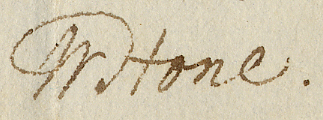The William Hone Correspondence
Hone was a prolific correspondent, and many of his letters are highly personable showing the characteristic parodic wit that marks his more popular publications. This section of the BioText is very much a work in progress. At present, the page presents an index of the letters written by Hone. With only a very few exceptions, each of the letters is edited from the manuscript; almost all of the manuscripts are archived in one of the repositories listed in the "Archives" section of the BioText.
In this index, each letter is listed in chronological order with information about the archival source and about any previous publication of the letter. Where possible, I have also included a brief synopsis of the contents of the letter. As I complete the editing of each of the four chronological sections, I will also include links to the full text of each of Hone's letters. (The first section, 1780-1818, offers a glimpse of the full-text correspondence.) I have also included here a short "Who's Who" document that identifies many of the key figures who appear in Hone's correspondence.
- Hone Letters, 1780-1818; early public life up through the Trials of 1817.
- Hone Letters, 1818-1824; the years of Hone's greatest fame as a political pamphleteer.
- Hone Letters, 1825-1832; the years of Hone's antiquarian publications such as the Every-Day Book
- Hone Letters, 1832-1842; the final years of Hone's career covering his religious conversion and his work for The Patriot.
- Undated Letters.
- Who's Who in Hone's Letters.
Hone's correspondence is voluminous with many individual letters tucked away in unlikely archives in the UK, the USA, and Australia. As the Correspondence section develops it will, of course, include additional Hone letters as they are cataloged in my ongoing research. In addition the section will offer a selection of the letters written to Hone, and it will develop a set of epistolary "conversations" focusing on specific correspondents or on specific events. Two of these "conversations" are currently available:
- John Childs and William Hone in 1819--Printing, Politics, and a Developing Friendship
- Robert Southey and William Hone--Conflict and Rapprochement
A technical note:
Each of these letters and documents is being transcribed into a plain text file which is then tagged using the TEILite specifications (P5) within the oXygen development software (version 12.2). The resulting XML files are transformed into HTML using a modified and edited version of the freely available XSLT stylesheets from the TEI website (and built into oXygen). Finally, the HTML files are edited slightly to ensure that they conform to the CSS stylesheets written specifically for the BioText.. When the project is complete, all of the underlying TEI-conformant files will be made available along with the more easily web-readable HTML files. More information about editorial principles and encoding practices is available here.
